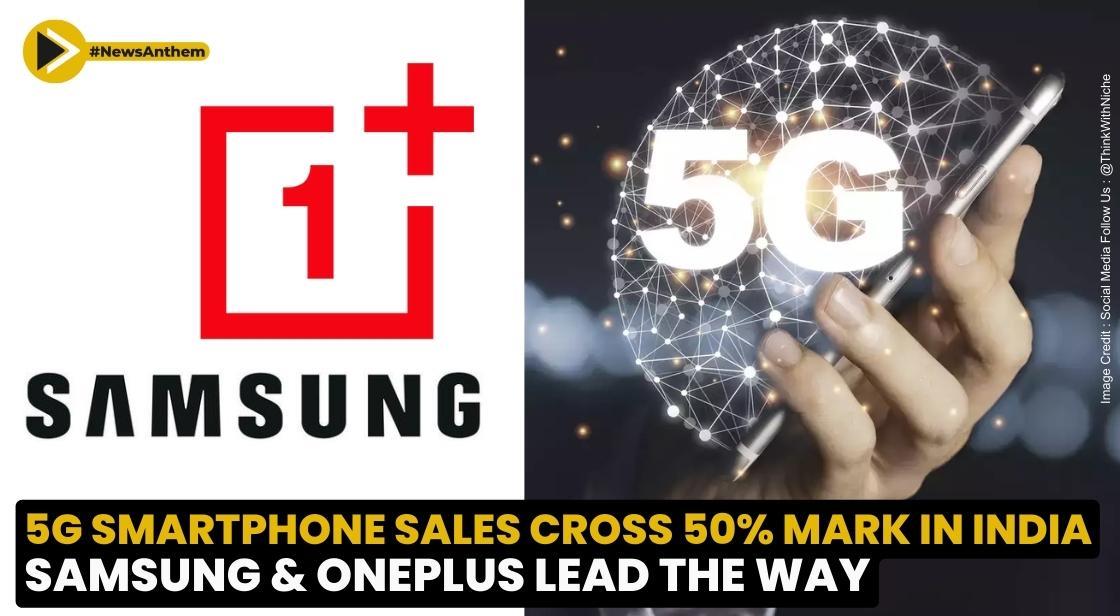5G Smartphone Sales Cross 50% Mark in India : Samsung and OnePlus Lead the Way

News Synopsis
5G Smartphone Sales Cross 50% Mark in India
The sales share of 5G smartphones in India reached a significant milestone in April, surpassing the 50% mark, according to data by Counterpoint Research. This surge can be attributed to several factors, including the increased rollout of 5G networks and consumers' growing preference for 5G-enabled devices.
Analysts highlight the significance of this achievement, considering the existing limitations in network coverage across the country. However, this development marks a crucial step towards the widespread adoption of 5G technology in India.
Decline in Sales Share of 4G Smartphones
Counterpoint Research reports a notable decline in the sales share of 4G smartphones in India from November 2022 to April 2023. In November last year, 4G smartphones accounted for 64% of sales, while 5G smartphones held a 36% share.
However, in April 2023, the sales share of 4G smartphones fell to 50%, while 5G smartphones rose to an equal 50%. This shift underscores the increasing preference of consumers for 5G devices and their inclination towards upgrading to the latest technology.
Samsung and OnePlus Lead the 5G Smartphone Market
In the race for dominance in the 5G smartphone market, Samsung and OnePlus emerged as frontrunners in India. According to Counterpoint Research, Samsung played a significant role in driving 5G adoption, while OnePlus achieved remarkable success, capturing a third of all 5G sales.
The January-March quarter witnessed 5G smartphones contributing to a record-breaking 43% of total mobile shipments, with Samsung leading the pack with a 24% market share. This indicates the growing demand for 5G-enabled devices from Indian consumers.
Samsung and OnePlus Lead the 5G Smartphone Market
Despite the impressive growth of 5G smartphone sales, the overall smartphone market in India faced challenges in the January-March quarter. Data from Counterpoint and Canalys revealed a 19-20% decline in smartphone shipments, marking the highest-ever decline in the first quarter.
Sluggish demand, high inventory build-up, and an increasing preference for refurbished phones contributed to this downturn. However, industry analysts remain optimistic about the long-term potential of the Indian smartphone market.
Future Outlook: 5G Adoption and Market Dynamics
According to Crisil, out of the 150-170 million annual smartphone shipments in India, approximately 30-35% are currently 5G-enabled. This indicates a significant opportunity for further growth and expansion of the 5G smartphone market.
As network coverage improves and more affordable 5G devices become available, the adoption rate is expected to accelerate. With Samsung and OnePlus leading the way, other smartphone manufacturers are likely to intensify their efforts to capture the growing demand for 5G-enabled smartphones.
The future outlook for 5G adoption in India is promising. As network infrastructure continues to develop and expand, the availability of 5G services is expected to increase across the country.
This will drive the demand for 5G smartphones, as consumers seek to leverage the benefits of faster download and upload speeds, lower latency, and enhanced connectivity for a wide range of applications.
Furthermore, the government of India has expressed its commitment to promoting and facilitating the adoption of 5G technology. Initiatives such as the National Digital Communications Policy and the establishment of test beds for 5G trials indicate a proactive approach to foster a conducive environment for 5G deployment.
In addition to the improved network infrastructure and government support, the increasing affordability of 5G devices will play a crucial role in driving adoption.
As more smartphone manufacturers introduce competitively priced 5G smartphones, it will become more accessible to a broader consumer base. This will further propel the market dynamics and contribute to the overall growth of the 5G smartphone segment.
Moreover, the transformative potential of 5G extends beyond smartphones. Industries such as healthcare, manufacturing, transportation, and entertainment are poised to benefit from the advanced capabilities of 5G networks.
The Internet of Things (IoT) ecosystem will also witness significant expansion with the proliferation of 5G, enabling seamless connectivity and communication between devices and systems.
However, challenges remain in terms of network coverage and infrastructure deployment, particularly in rural and remote areas. Addressing these challenges will require continued investments and collaborations between telecommunication companies, government bodies, and other stakeholders.
Conclusion
The future of 5G adoption in India holds immense potential. With a significant portion of annual smartphone shipments projected to be 5G-enabled, the market dynamics are set to evolve rapidly.
Improved network coverage, government support, affordability, and the transformative impact of 5G technology across industries are all contributing factors to the positive outlook.
As the ecosystem continues to mature, India is well-positioned to embrace the full potential of 5G and unlock new opportunities for innovation, connectivity, and economic growth.
You May Like









